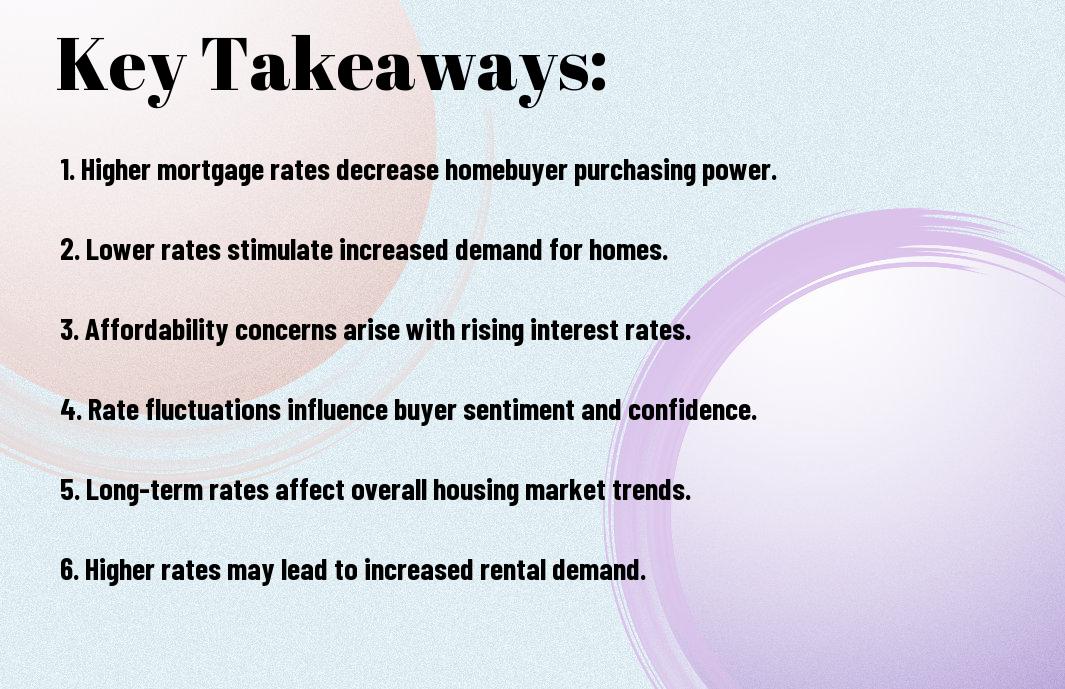Most buyers often overlook how significantly mortgage rates can influence the housing market. When you understand the relationship between mortgage rates and market demand, you can make more informed decisions about buying or selling a home. Changes in interest rates can affect your purchasing power, dictate market trends, and ultimately determine the timing of your real estate transactions. In this post, we’ll explore how fluctuations in mortgage rates directly impact your home search and the overall demand for homes in your area.
Key Takeaways:
- Higher mortgage rates tend to decrease market demand for homes as buyers face increased borrowing costs, making home purchases less affordable.
- Conversely, lower mortgage rates can stimulate demand, encouraging more buyers to enter the market, which can drive home prices up due to increased competition.
- Market demand is also influenced by other factors like employment rates and economic conditions, which can interact with mortgage rate changes to impact buyer behavior.
Understanding Mortgage Rates
A mortgage rate is the interest percentage you pay on your home loan. This rate plays a vital role in determining your monthly payment. It can fluctuate based on various economic and personal factors, influencing whether you can afford a home or not. Understanding how these rates work is vital for making informed decisions in the home-buying process.
Definition of Mortgage Rates
After securing a mortgage, you’ll commit to paying back the loan over a set term, typically 15 or 30 years. The mortgage rate represents the cost of borrowing that money, significantly impacting your overall financial investment in the property.
Factors Influencing Mortgage Rates
With multiple variables affecting mortgage rates, understanding these factors can help you anticipate changes in your home loan costs. Some key influencers include:
- Your credit score
- The economic environment
- The Federal Reserve’s policies
- The length of the loan term
- The type of mortgage you choose
Knowing how these elements interplay can empower you to make strategic choices in your housing market journey.
In fact, each of these factors contributes to the overall interest rate you may receive. For instance, higher credit scores typically earn better rates, while economic downturns can increase borrowing costs. Additional elements include:
- The demand for housing in your area
- Your down payment amount
- The overall health of financial markets
Knowing how to navigate these influences can significantly enhance your financial strategy when entering the housing market.
The Relationship Between Mortgage Rates and Housing Demand
Some homeowners and potential buyers are often influenced by fluctuations in mortgage rates. These rates play a significant role in shaping housing demand, as they directly impact your monthly mortgage payments. When mortgage rates are low, more buyers can enter the market, while higher rates may discourage investment in homeownership, leading to fluctuations in demand.
Impact of Low Mortgage Rates
About low mortgage rates can dramatically increase your purchasing power, allowing you to afford a more expensive home or secure a larger loan. When rates decrease, you may find that more buyers are motivated to enter the market, creating heightened competition for homes. This influx of demand can lead to rising home prices as a result of increased buyer interest.
Consequences of Rising Mortgage Rates
Below rising mortgage rates can put a damper on housing demand as they increase your borrowing costs. Consequently, higher rates often lead to fewer buyers being able to afford a mortgage, resulting in declining demand for homes. This can create a slowdown in the housing market, with potential buyers hesitating, leading to longer days on the market for homes and, in some cases, lower home prices. As the balance shifts, you may notice a stagnation in sales, creating an environment in which sellers become more negotiable with their pricing.
Regional Variations in Housing Demand
Once again, it is important to recognize that housing demand can differ significantly based on geographic location. Factors such as local economies, job markets, and population growth all play critical roles in determining how mortgage rates impact demand in various regions. For you as a potential buyer or seller, understanding these regional variations can help you make informed decisions in your real estate journey.
Urban vs. Rural Markets
On the whole, urban markets tend to experience higher demand for homes due to their proximity to employment opportunities and amenities. However, rural markets often present unique benefits, like lower prices and spacious properties. As you consider your options, keep in mind how mortgage rates can influence demand differently in urban and rural settings.
Economic Indicators Affecting Regional Demand
Before submerging into the housing market, it’s vital to understand the economic indicators that significantly influence regional demand. Factors such as unemployment rates, income levels, and local economic growth can drive or dampen interest in home buying, affecting how mortgage rates interact with demand in your area.
Demand for housing is not solely influenced by mortgage rates; economic indicators also serve as significant drivers. For example, a declining unemployment rate often signals a strengthening job market, which leads to increased consumer confidence and higher housing demand. Conversely, rising unemployment can diminish buyer interest, even if mortgage rates are low. Analyzing these economic indicators will empower you to better anticipate market trends and make strategic decisions based on your personal circumstances.
Consumer Behavior and Decision-Making
Many factors influence consumer behavior in the housing market, particularly mortgage rates. When you consider buying a home, your perception of affordability and monthly payments will heavily depend on current mortgage rates. As these rates fluctuate, so too does your willingness to pursue purchasing a property, impacting overall market demand.
Homebuyer Sentiment
Below the surface of statistics lies homebuyer sentiment, which significantly shapes your decision-making process. If you sense that mortgage rates are rising, you might feel pressured to act quickly to secure a lower rate, ultimately influencing demand and competition in the housing market.
Timing the Market
At some point, you may contemplate timing your entry into the housing market based on changes in mortgage rates. This consideration often leads you to monitor interest rate trends and make strategic decisions on when to buy, which can amplify fluctuations in market demand.
Also, the idea of timing the market pressures you to stay informed about economic conditions and financial forecasts. You may analyze past trends in mortgage rates to determine optimal purchasing times, hoping to leverage favorable conditions. However, this strategy can be risky; waiting too long for a drop in rates might lead to missed opportunities or increased housing prices, shifting demand in unpredictable ways.
Long-term Implications of Mortgage Rate Trends
To understand the long-term implications of mortgage rate trends, it’s vital to recognize how these rates directly influence market dynamics. As mortgage rates fluctuate, they can either encourage or deter home buyers, affecting overall demand and housing inventory. For insights into this relationship, check out What a Recession Would Mean for the Housing Market in …. A sustained period of high or low rates can shape housing market stability and your long-term investment decisions.
Market Corrections
Market corrections are natural responses to shifts in mortgage rates and can lead to price adjustments in the housing sector. When rates rise significantly, demand may decrease, causing sellers to lower prices to attract buyers. You should keep an eye on these trends, as they can present opportunities for advantageous purchases or sales.
Future Predictions for Home Sales
Market experts predict varied outcomes for future home sales depending on mortgage rate fluctuations. If rates increase, you may see a slowdown in sales as buyers step back, while decreasing rates could stimulate demand and competition, driving sales up. It’s imperative to stay informed about these trends to align your home buying or selling strategies.
Considering the current economic landscape, it’s important to evaluate how mortgage rates will influence your personal buying or selling decisions. With potential market corrections and fluctuating rates, being proactive can help you navigate the housing market effectively. Analyzing trends and forecasting future behaviors will empower you to make informed decisions, ensuring that you maximize your investment in real estate.
Conclusion
The impact of mortgage rates on market demand for homes is significant and directly affects your purchasing power. When rates are low, you are likely to see an increase in demand as more buyers enter the market, potentially leading to rising home prices. Conversely, higher rates can limit your budget and reduce overall demand, resulting in a balanced market or even falling prices. Understanding these dynamics can help you make informed decisions when buying a home and navigating the real estate landscape effectively.
Q: How do rising mortgage rates influence homebuyer affordability?
A: When mortgage rates increase, the cost of borrowing money to purchase a home also rises. This typically results in higher monthly mortgage payments, which can strain a buyer’s budget. Consequently, many potential buyers may decide to wait for rates to decrease before making a purchase, thereby reducing overall demand in the housing market. Additionally, first-time buyers, who are often more sensitive to changes in interest rates, may find themselves priced out of the market.
Q: What happens to home sales when mortgage rates decrease?
A: A decline in mortgage rates generally makes home buying more affordable, which can stimulate demand in the housing market. Lower interest rates mean lower monthly payments for buyers, allowing them to qualify for larger loans and purchase more expensive homes than they might have been able to otherwise. This increased affordability can lead to a surge in home sales, prompting sellers to enter the market as well, creating a more dynamic buying environment.
Q: Are there other factors besides mortgage rates that affect market demand for homes?
A: Yes, mortgage rates are just one element influencing market demand. Other factors include economic conditions—such as employment rates and wage growth—which impact consumer confidence and purchasing power. Additionally, demographic trends, housing supply, changes in local real estate laws, and seasonal trends can all affect demand. For instance, in a robust economy, even higher mortgage rates might not deter buyers, while in a weaker economy, even lower rates might not be enough to stimulate demand.






